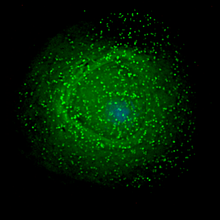Statins Lower Cancer Risk in HIV-1–Infected Patients Taking ART
Increasing clinical evidence suggests that statins may help prevent cancer in certain HIV-1–infected patients. Details here.
HIV assembling on the surface of an infected macrophage. (Courtesy Wikipedia.)

Statins use appears to lower the risk of cancer among HIV-1–treated patients: the benefit is mainly related to AIDS-defining malignancies, according to the first large, long-term study of patients with different degrees of HIV disease.
“Our study shows that the use of statins is associated with a 55% reduction in cancer occurrence among treated HIV-1–infected individuals; this effect appeared to be even stronger in relation to the AIDS-defining malignancies that were not observed in individuals taking statins,” state the authors, led by Laura Galli of Infectious Diseases Department, San Raffaele Scientific Institute University of Vita-Salute, San Raffaele, in Milan, Italy.
HIV infection is associated with an increased risk of cancer even in the era of highly active antiretroviral therapy (ART). Since the introduction of combination ART, the incidence of AIDS-defining cancers has decreased and that of non–AIDS-defining cancers has risen.
ART is started early in an attempt to prevent potentially irreversible immune dysfunction. The additional use of anti-inflammatory treatments, such as statins or aspirin, is now under investigation to help prevent or reduce inflammation and consequently comorbidities. “Increasing clinical evidence suggests that statins may play a role in the prevention and treatment of cancer due to their effect on serum cholesterol levels and their interactions with essential cellular proliferation and differentiation mechanisms,” they state.
The researchers conducted a large cohort study to evaluate the effect of statin therapy on the occurrence of all AIDS-defining malignancy and non–AIDS-defining malignancy among 5357 HIV-positive patients with no previous cancer diagnosis and no previous use of statins. During a follow-up period of 10 years, 740 of these patients used statins and 4617 did not.
During more than 52,000 person-years, 375 malignancies occurred, including 12 malignancies (1.6%) among statin users and 363 malignancies (7.9%) among non-statin users. Multivariate analysis showed that statin use was associated with a lower risk of cancer. Older age, a shorter ART duration, lower current CD4+ levels, and higher viral load were additional independent risk factors for cancer occurrence.
Cancer among statins users was unrelated to the number of statins used (7 and 5 patients used 1 and 2 statins, respectively) or to the type of statin (4 patients used only rosuvastatin, 3 patients used only pravastatin; 3 patients used both rosuvastatin and pravastatin; 2 patients used rosuvastatin and atorvastin or fluavastatin).
“Although we had detailed information about the type and dose of statin dispensed, we were unable to examine associations between statin type and cancer occurrence, as a large majority of the statin users used only one type of statin (81% treated with rosuvastatin) as well as the number of individuals receiving high doses of statin was small,” they state.
The researchers conclude that “these findings suggest that statin use may have a potential role, as a concomitant treatment of ART, not only for treatment of dyslipidemia and cardiovascular complications but also for cancer prevention.”
The researchers reported their results in the October 23, 2014, issue of AIDS.
IDWeek 2023: New Data Provide Closer Look at Real-World Utilization of Cabotegravir for HIV PrEP
October 15th 2023IDWeek 2023. New study found just slightly more than half of prescriptions for cabotegravir for HIV PrEP resulted in at least 1 injection, suggesting limitations in use and access to the injectable HIV integrase inhibitor.
Common Side Effects of Antiretroviral Therapy in HIV Infection
February 7th 2013What are some of the more common side effects of antiretroviral therapy, and what can the primary care physician do to help manage these effects? In this podcast, infectious disease expert Rodger MacArthur, MD, offers insights and points readers to updated comprehensive guidelines.